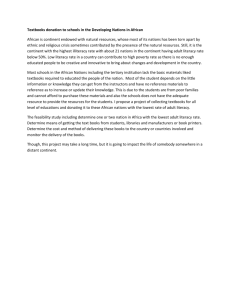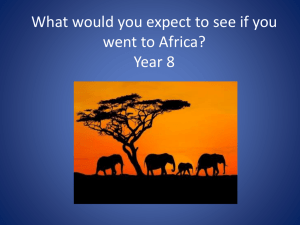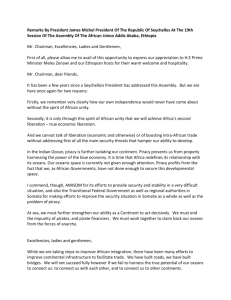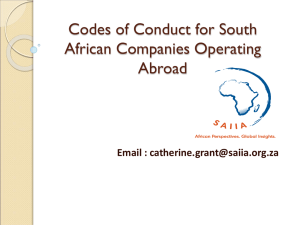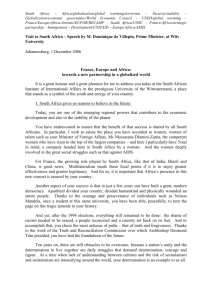Science, Engineering, and Technology (SET) Leadership for
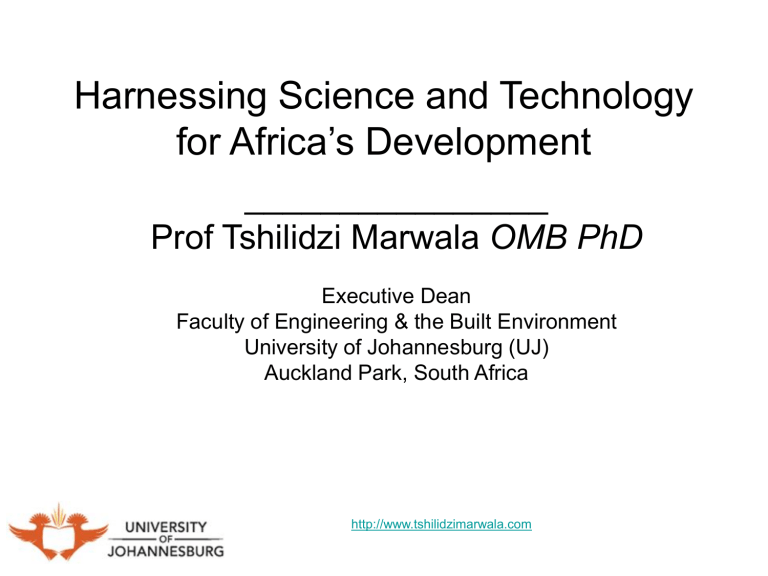
Harnessing Science and Technology for Africa’s Development
________________
Prof Tshilidzi Marwala OMB PhD
Executive Dean
Faculty of Engineering & the Built Environment
University of Johannesburg (UJ)
Auckland Park, South Africa http://www.tshilidzimarwala.com
Overview
• Africa Today
• Africa in 30 Years Time
• Where should Africa be in 2050?
• Current Challenges
• Bridging the Expectation Gap
• Scientific areas needed for Africa’s development
• Open Questions
• Conclusions and Questions http://www.tshilidzimarwala.com
Africa Today
• The African continent currently has a total annual GDP of US$1.6 trillion (McKinsey & Co);
• Its economy is the third fastest growing region on the planet after China and India;
• In 2009 it recorded an estimated 5% growth and thus added US$70 billion to the World economy;
• The African continent has over 1 billion people
• The literacy rate is at an all-time high
• The continent is more democratic than ever before http://www.tshilidzimarwala.com
Africa in 30 Year’s Time
• Nigeria will become the largest economy in continent in less than 20 years time.
• The African continent will have over 2 billion people in 40 years
• The African economy will be more integrated
• The levels of democratization will be greatly expanded
• The number of educated people will be much more than today http://www.tshilidzimarwala.com
Where should Africa be in 2050?
• Factory floor for the world economy
• 80% of people should be literate
• Decreased levels of epidemics and pandemics
• Much more secured nations and coast lines
• High levels of communication connectivity
• Environmentally friendly continent
• Increased number of people who are trained in
Science and Technology
• More people with postgraduate qualifications http://www.tshilidzimarwala.com
Current Challenges
Financial
Stability
Economic
Stability
African System
Energy crisis
Food
Security
Political
Stability
Courtesy Dr. C. Nonkwelo
Bridging the Gap
• Positioning of Science and Technology within the political, social and economic spaces
• Building and Expanding Institutions that support Science and Technology
– Expanding Educational Infrastructures
– Expanding research and development infrastructure
What is Science?
• “systematic enterprise of gathering and condensing knowledge into testable laws and theories” wikipedia
• Scientific method has been developed to deal with complex phenomena
• Examples: Physical Science, Biological
Science, Mathematical Sciences
What is Technology?
• The objects or processes that are derived from the application of science
• Examples: Communication Technology
(object: cell phone); Biomedical technology (object: stethoscope)
Bridging the Gap: Political Space
• We need to invest in Science and Technology
(South Africa invests less than 1% of GDP into research in S&T)
• We need to support and expand state institutions such as the CSIR and NRF
• We need to increase our capacity to formulate and implement Science and Technology (S&T)
Policy.
• We need to develop capacity to produce and exploit intellectual property
• We need to develop mechanisms to better trade of scientific goods
Bridging the Gap: Social Space
• We need to increase scientific literacy within the general populace
• We need to use community infrastructures to increase the capacity to produce students with Mathematics and Science competency
• Get communities to adopt technological tools to improve their quality of life
Bridging the Gap: Economic Space
• We need to use science and technology to increase economic participation
• We need to invest into strategic technologies that would increase competitiveness
• We need to use S&T to solve problems such as food shortage
Some areas critical for Africa’s
Development
• Space sciences
• Energy
• Biotechnology
• Information & communications technology
• Climate change
Space sciences
• Remote sensing to increase visibility of areas of geographic importance e.g. land usage and agriculture
• Monitoring of the coast lines e.g. enforce fishing rights
• Communication e.g. satellite communication
• Understand the evolution of the universe e.g.
Square kilometers array
Energy
• Diversify energy sources
– Nuclear
– Hydro
– Biomass
– Solar
• Put emphasis on renewable energy
• Integrate the African energy pool
• Efficient utilization of energy
Biotechnology
• Indigenous pharmaceutical production
• Genetically modified crops
• Increase fuel production e.g. ethanol
• Bioinformatics
• Blue biotechnology – marine and aquatic applications of biotechnology
• Green biotechnology
• Red biotechnology – application to medicine
• White biotechnology – application to industrial processes
Information & communications technology
• Connectivity
• Computing
• Internet
• Broadband
• Digitization
• Computational/Artificial intelligence
• Outsourcing
• Call centres
Climate change
• Risks of coastal flooding
• Risks of droughts
• Desertification
• Diseases
• Destruction of the ecosystem
Open Questions?
• What are other S&T areas of criticality for
Africa’s Development?
• What is the role of African integration on promoting S&T?
• What is the role of African leadership in promoting S&T?
• How do we stop and reverse brain drain in the
S&T sector?
• How do we use S&T to modernize the African community?
Open Questions?
• What is the relationship between S&T and the future of mankind?
• How do we effectively use innovation to drive economic growth?
• What is the optimal investment into S&T to drive development?
• How do we effectively invest into S&T to improve health?
Open Questions?
• How do we build the Post Kyoto world?
• What is the impact of ICT on economy, society and quality of life?
• What is the optimal combination of energy sources to ensure the security of supply?
• What is the political economy of S&T?
